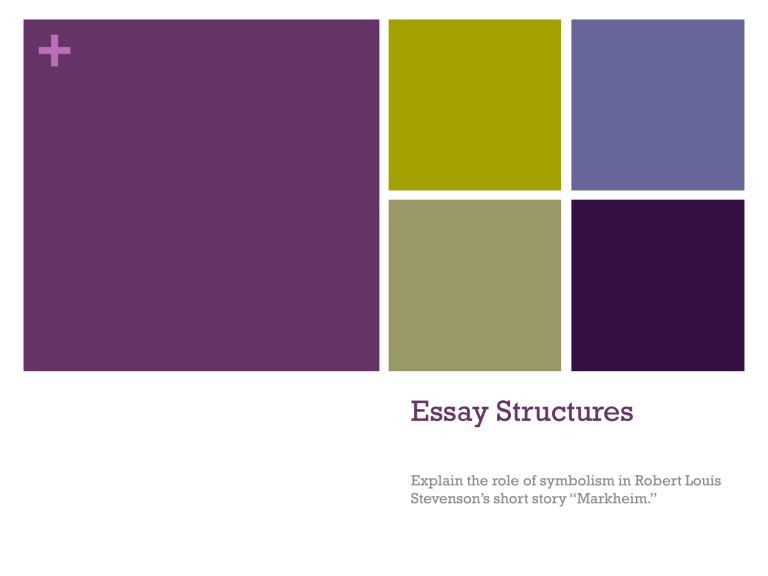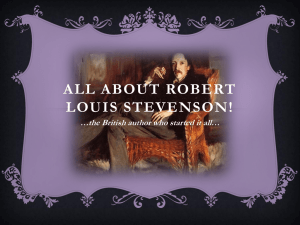Symbolism essay: "Markheim" - Stjohns

+
Essay Structures
Explain the role of symbolism in Robert Louis
Stevenson’s short story “Markheim.”
+
D
AYT
C
S
T
MEAEAL
#1
MEAEAL
#2
MEAEAL
#3
Review your thesis
Statement in separate brought up (D)
Essay Structure for
Visual Learners
Start broadly in your introduction and narrow your focus down to your thesis statement.
This presents a smooth flow, right from the initial definition of your topic to your specific argument.
Focus on the topic, not summarizing the text!
+
INTRODUCTIONS
DAYTCST
+
Explain the role of symbolism in Robert Louis Stevenson’s short story “Markheim.”
Thesis statement—which is best?
In his 1885 short story “Markheim,” author Robert Louis Stevenson uses symbolism to further his message about good and evil.
In his 1885 short story “Markheim,” author Robert Louis Stevenson uses symbols, such as the clocks, mirrors, and light, to show the importance of being good.
In his 1885 short story “Markheim,” author Robert Louis Stevenson uses symbols, such as the clocks, mirrors, and light, to demonstrate the importance of righteousness and repentance.
+
Focusing on Definitions
Why define?
Words and terms have varied meanings!
Think of how many ways we could define “gender,” for example.
Or, think of how many ways we could define other qualities like
“strength,” a trait so often explored in literature.
What do we define?
What term is crucial for a reader of your essay to understand?
You might also think of your definition as a description of your key term or guiding concept.
Consider your argument. What terms need to be defined, described, or identified?
For our essay on symbolism, your “D” sentences depend on your argument. Pay careful attention to how these “D” sentences affect the flow of your introduction overall.
+
Which is the best start to an introduction? Why?
How do good and evil affect the soul? Is the character of a man defined by his actions or his heart? In his 1885 short story “Markheim,” author Robert Louis
Stevenson explores the effect of sin on an individual.
An author of the Victorian era,
Stevenson’s short story reflects Christian values and encourages readers to admit to their sins, no matter their gravity, and commit to living a life of honesty and righteousness. The protagonist of the short story, Markheim, murders the owner of a curio shop in order to steal his money but in the end turns himself in after a supernatural being, possibly representing his conscience, encourages him to examine his sins and do the right thing.
While Markheim’s evolution of character is clear evidence of the selfawareness Stevenson promotes, symbolism is also a very important technique the author uses to communicate his message.
Stevenson’s use of symbols, such as the mirrors, clocks, and light, demonstrate the importance of righteousness and repentance.
Symbolism is a technique frequently used by authors to reflect themes or further character development.
In his 1885 short story “Markheim,” author
Robert Louis uses symbolism to communicate themes in the text. An author of the Victorian era, Stevenson’s short story reflects Christian values and encourages readers to admit to their sins, no matter their gravity, and commit to living a life of honesty and righteousness. The protagonist of the short story, Markheim, murders the owner shop in order to steal his money but in the end turns himself in after a supernatural being, possibly representing his conscience, encourages him to examine his sins and do the right thing.
While
Markheim’s evolution of character is clear evidence of the self-awareness Stevenson promotes, symbolism is also a very important technique the author uses to communicate his message. Stevenson’s use of symbols, such as the mirrors, clocks, and light, demonstrate the importance of righteousness and repentance.
+
BODY PARAGRAPHS
MEAEAL
+
Prewriting: Outlining and Webbing
I.
A.
B.
C.
i.
i.
ii.
i.
Mirrors passage of time
“damned reminder of years, and sins and follies—this handconscience” (41).
“sins,” “follies,” “conscience,” more than examining the external
“startled to the soul by chance reflections” (42) as he sees “his face repeated and repeated, as…an army of spies” (43)
“soul” mirrors force Markheim to examine internally
“spies” conscience
“Markheim steadily regard[s] his counsellor” (52)
Like examining his own face in a mirror, confronting soul & past
II.
symbols = Markheim’s evolution as a character, importance of self-awareness & repentance.
+
Prewriting: Outlining and Webbing
“soul” mirrors force
Markheim to examine internally
“spies” conscience
“sins,” “follies,” “conscience,” more than examining the external
“damned reminder of years, and sins and follies—this handconscience” (41).
“startled to the soul by chance reflections”
(42) as he sees “his face repeated and repeated, as…an army of spies” (43)
Mirrors passage of time
“Markheim steadily regard[s] his counsellor”
(52)
Like examining his own face in a mirror, confronting soul & past
CONCLUSION: symbols = Markheim’s evolution as a character, importance of self-awareness & repentance.
+ In his 1885 short story “Markheim,” author Robert Louis Stevenson uses symbols, such as the mirrors, clocks, and light, to
E
A
L
M
E
A
E
A demonstrate the importance of righteousness and repentance.
Throughout the short story, mirrors are powerful symbols used to remind Markheim of the passage of time and to encourage him to reexamine the life he leads. At the beginning of the short story, when Markheim refuses the dealer’s suggestion of giving his lady a mirror for Christmas, Markheim states that the mirror is a “damned reminder of years, and sins and
follies—this hand-conscience” (41). While it may be obvious that a mirror reflects one’s age, by adding the words “sins,” “follies,” and “conscience,”
Stevenson implies that the mirror, looking at one’s own reflection, should be more than examining the external; it also involves examining internal flaws and past indiscretions. After Markheim murders the dealer, he realizes he is surrounded by mirrors in the shop and is “startled to the soul by chance
reflections” (42) as he sees “his face repeated and repeated, as…an
army of spies” (43). As previously, the mirror is more than a superficial reflection. The word “soul” allows the reader to infer that the mirrors are forcing Markheim to examine what he has done and how it has affected his soul. Comparing each reflection to “spies” further emphasizes the fact that, at some level, Markheim is aware of his actions and their impact . Towards the end of the story, when the supernatural being, arguably Markheim’s doppelganger, obliges Markheim to recognize his sins, “Markheim steadily regard[s] his counsellor” as though examining his own face in a mirror, confronting his own soul and past (52) . It is clear that mirrors are more than pieces of glass in “Markheim.” They in fact are symbols indicating
Markheim’s evolution as a character and emphasizing the importance of selfawareness and repenting for one’s sins.
+ In his 1885 short story “Markheim,” author Robert Louis Stevenson uses symbols, such as the mirrors, clocks, and light, to
E
A
L
M
E
A
E
A demonstrate the importance of righteousness and repentance.
Throughout the short story, mirrors are powerful symbols used to remind Markheim of the passage of time and to encourage him to reexamine the life he leads. At the beginning of the short story, when Markheim refuses the dealer’s suggestion of giving his lady a mirror for Christmas, Markheim states that the mirror is a “damned reminder of years, and sins and
follies—this hand-conscience” (41). While it may be obvious that a mirror reflects one’s age, by adding the words “sins,” “follies,” and “conscience,”
Stevenson implies that the mirror, looking at one’s own reflection, should be more than examining the external; it also involves examining internal flaws and past indiscretions. After Markheim murders the dealer, he realizes he is surrounded by mirrors in the shop and is “startled to the soul by chance
reflections” (42) as he sees “his face repeated and repeated, as…an
army of spies” (43). As previously, the mirror is more than a superficial reflection. The word “soul” allows the reader to infer that the mirrors are evidence, I never use forcing Markheim to examine what he has done and how it has affected his soul. Comparing each reflection to “spies” further emphasizes the fact that, at some level, Markheim is aware of his actions and their impact quotation shows.”
. Towards the end of the story, when the supernatural being, arguably Markheim’s doppelganger, obliges Markheim to recognize his sins, “Markheim steadily regard[s] his counsellor” as though examining his own face in a mirror, confronting his own soul and past (52) . It is clear that mirrors are more than pieces of glass in “Markheim.” They in fact are symbols indicating
Markheim’s evolution as a character and emphasizing the importance of selfawareness and repenting for one’s sins.
+
CONCLUSIONS
A mirror image of the introduction
+
Writing Your Conclusion
Use your argument as inspiration!
Remember, five paragraph essays are the foundation of your essay-writing futures—reviewing your argument and wrapping up your ideas is more and more important as papers become longer and longer.
Have trouble with them? Follow this pattern:
Sentence 1: Review your argument
Sentence 2: Review your first body section
Sentence 3: Review your second body section
Sentence 4: Review your third body section
Transitional sentences (probably 1-3 sentences)
Overall wrap-up (1-3 sentences commenting upon your opening
“D” sentences)
+
Many might say that one’s character is defined by what is in his or her heart rather than his or her actions, but others might contend that one’s sins mark him or her forever. In his 1885 short story “Markheim,” author Robert
Louis Stevenson explores the effect of sin on an individual.
An author of the Victorian era, Stevenson’s short story reflects Christian values and encourages readers to admit to their sins, no matter their gravity, and commit to living a life of honesty and righteousness. The protagonist of the short story,
Markheim, murders the owner of a curio shop in order to steal his money but in the end turns himself in after a supernatural being, possibly representing his conscience, encourages him to examine his sins and do the right thing.
While Markheim’s evolution of character is clear evidence of the self-awareness Stevenson promotes, symbolism is also a very important technique the author uses to communicate his message. Stevenson’s use of symbols, such as the mirrors, clocks, and light, demonstrate the importance of righteousness and repentance.
With the help of symbolism, Robert Louis
Stevenson is able to effectively communicate to his readers that there is only one life to live and that although all people may commit sinful actions, it is important to confront those sins and repent. The mirrors serve as a symbol of self-reflection and indicate the importance of examining one’s own character. The clocks represent the passage of time and reality of mortality. The light, mostly reflected in the presence of the candle throughout the short story, symbolize honesty with oneself and others. While
“Markheim” at first seems like a simple tale of an immoral man, the symbols in the text work together to prove its depth and relevance. By the story’s end, it is clear that a man is defined by his heart and his soul; everyone does something wrong at some point, but being honest with oneself and with God helps one to judge what is right for wrong and to repent for past sins.
+
My Working Conclusion…
Stevenson’s use of symbols, such as the mirrors, clocks, and light, demonstrate the importance of righteousness and repentance.
Many might say that one’s character is defined by what is in his or her heart rather than his or her actions, but others might contend that one’s sins mark him or her forever.
With the help of symbolism, Robert Louis
Stevenson is able to effectively communicate to his readers that there is only one life to live and that although all people may commit sinful actions, it is important to confront those sins and repent in order to live a more righteous life. The mirrors serve as a symbol of self-reflection and indicate the importance of examining one’s own character.
The clocks represent the passage of time and reality of mortality. The light, mostly reflected in the presence of the candle throughout the short story, symbolizes honesty with oneself and others.
While “Markheim” at first seems like a simple tale of an immoral man, the symbols in the text work together to prove its depth and relevance. By the story’s end, it is clear that a man is defined by his heart and his soul; everyone does something wrong at some point, but being honest with oneself and with God helps one to judge what is right for wrong, to repent for past sins, and to change for the better.










